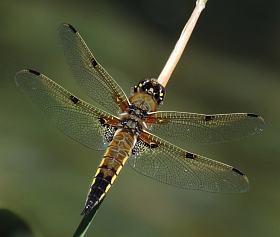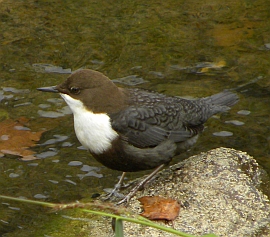 |
Picos de Europa:
a naturalist's paradise
- part 4
by Teresa Farino
The glacial lakes of the northern reaches
Another high-level focal point of the Picos de Europa is the Covadonga
glacial lakes: Enol and La Ercina. The surrounding sward is kept short by herds
of the autochthonous casina cattle which spend the summer
 Four-spotted Chaser Libellula quadrimaculata
© Teresa Farino
here, but nevertheless produces a breathtaking display of hoop-petticoat
daffodils and dog's-tooth-violets in spring and merendera in late summer. Limestone outcrops around the lake are worth
examining for blue-leaved petrocoptis, confined to the Cordillera Cantábrica,
Pyrenean lousewort and deep-purple-flowered clumps of the Picos de Europa's endemic toadflax Linaria faucicola.
Four-spotted Chaser Libellula quadrimaculata
© Teresa Farino
here, but nevertheless produces a breathtaking display of hoop-petticoat
daffodils and dog's-tooth-violets in spring and merendera in late summer. Limestone outcrops around the lake are worth
examining for blue-leaved petrocoptis, confined to the Cordillera Cantábrica,
Pyrenean lousewort and deep-purple-flowered clumps of the Picos de Europa's endemic toadflax Linaria faucicola.
An additional attraction of the lakes is the tens of thousands of common and azure bluets that swarm around the margins in mid-June. The peripheral beds of bogbean and sedges
should also reward you with four-spotted chaser, blue emperor, keeled skimmer, common goldenring and red-veined and ruddy darters. Look out too for Iberian rock lizard in rocky
habitats, rock thrush around the cliffs at the southern end of La Ercina, and
citril finch in the beech forests slightly further afield.
La Garganta Divina
 Dipper Cinclus cinclus
© Teresa Farino
Dipper Cinclus cinclus
© Teresa Farino
The Garganta del Cares is probably the pick of the river gorges which dissect the
Picos de Europa. An 11km trail follows the whole length of this steep-sided chasm,
often several hundred metres above the river, giving you a good chance of spotting
wallcreeper in winter and black woodpecker (in small enclaves of broad-leaved forest)
at any time of year. Crag martin and dipper are present all year
round, plus alpine swift in summer, with blue rock thrush a distinct
possibility at the northern end. Shady overhangs shelter maidenhair fern, round-leaved St John's-wort and large-flowered
butterwort, while sunny limestone rockgardens host sticky flax, woodcock
ophrys, fragrant orchid and dark-red helleborine.
Among the butterflies which frequent the warm, sheltered reaches of the gorge in June
are marbled skipper, Berger's clouded yellow, Moroccan
orange tip, violet fritillary, pearly and dusky heaths, marbled white and
Spanish purple hairstreak. To the south
of Caín, mixed deciduous woodland around Las Vegas is a noted haunt of
woodland brown, one of Europe's rarest butterflies, at a distance easy to
confuse with the rather similar ringlet: one of just three colonies known in
the Picos de Europa.
|